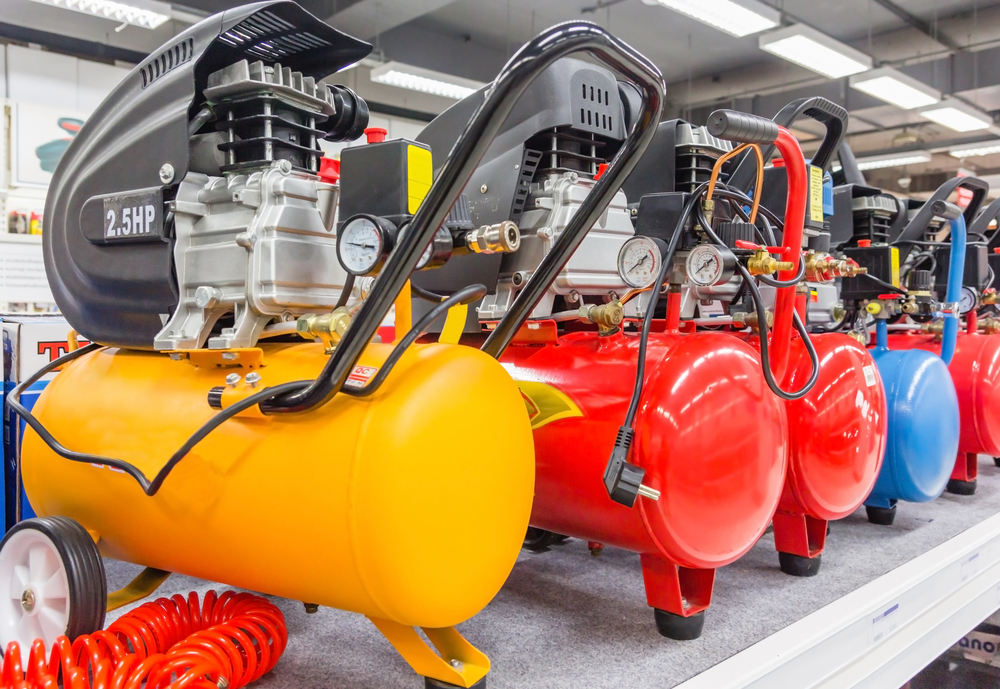Gardner-Denver manufactures equipment for pump systems, compression technology, and fluid control. For much of its more than 150-year history, the company used asbestos in many of its products, leading to exposure and diagnoses of mesothelioma, lung cancer, and other life-threatening diseases. People who were harmed after working with, installing, or servicing Gardner-Denver equipment may be eligible to seek compensation for their injuries.

Gardner-Denver Company History
The Gardner Governor Company was founded in 1859, when Robert W. Gardner created a new design for “fly-ball” governors that controlled steam engine speeds. His innovative devices quickly became popular in trades that used equipment that relied on steam power, especially oil drillers.
Over the next forty years, the company’s business was devoted exclusively to making and selling its governors to the oil and natural gas industry. Then, in 1890, Robert W. Gardner adapted existing steam pump technology to create mud pumps for drilling operations.[1]
Despite the demand for this product expanding significantly after the 1901 Spindletop Oil Field discovery in Texas, Gardner recognized that steam power would soon become outdated technology. He turned his attention to developing the vertical, high-speed air compressors that the company is still selling today.
By 1927, the company was being run by Robert’s son, J. Willis Gardner, who merged Gardner Governor with its largest customer, Denver Rock Drill Manufacturing Company. The newly formed Gardner-Denver Company offered equipment for oil wells, pipeline trenching, mining, dam construction, tunnel projects, and highway development.
Though the company was negatively impacted during the Great Depression, its business was helped in the mid-1930s by the massive infrastructure projects that the Roosevelt administration introduced to help get the nation back on its feet.
During World War II, Gardner-Denver Company built air compressors and mud pumps for the Navy to use on ships ranging from aircraft carriers to destroyers.[1] These pumps included asbestos-containing gaskets, packing, and insulation that put shipyard workers and crew members at risk of asbestos exposure for decades.
The company continued to operate independently until 1979, when it was acquired by Cooper Industries and reorganized into multiple divisions.
The Gardner-Denver Air Compressor Division and the Petroleum Equipment Division were consolidated in 1985 to form the Gardner-Denver Industrial Machinery Division, which then expanded through several strategic acquisitions of blower product lines and industrial compressor companies.
The company was eventually spun off and became independent again in 1994, continuing its acquisition of other companies and extending its product lines. It also expanded its international presence, operating as a global manufacturer and leader in compression technology, petroleum pumps, and fluid handling systems. It has production facilities in North America, Europe, Asia, and Latin America.[1]
In 2019, Gardner-Denver Holdings merged with the industrial division of Ingersoll-Rand, making the combined companies the world’s second-largest manufacturer of industrial pumps and compressors. The combined firm was expected to generate $6.6 billion in revenue.[2]
How Did Gardner-Denver Use Asbestos?
Gardner-Denver manufactured industrial equipment used for high-pressure and high-temperature applications, and through much of the 20th century. Many of its products incorporated asbestos-containing components that could withstand the extreme conditions and stress that the equipment was exposed to.
Its air compressors and pump systems needed heavy insulation and strong sealing materials that could stand up to intense heat and pressure shifts without breaking down.
Asbestos provided an ideal solution to this problem, as it offered superior fire resistance and durability. Gardner-Denver used asbestos in the insulation, gaskets, and packing materials, which it considered essential for their equipment to operate properly.
Historical product manuals show that Gardner-Denver’s mud pumps contained braided asbestos packing used to prevent fluid leakage around moving parts. As a result of normal wear and tear, these materials needed to be replaced often, and each time old packing was removed and new was installed, it sent asbestos particles into the air where they could be inhaled. These product manuals have been submitted as evidence in many lawsuits.
Gardner-Denver air compressors also contained asbestos gaskets that provided tight seals between separate components of the equipment. Like the asbestos packing, gaskets also need regular maintenance and replacement, putting workers tasked with servicing the compressors at additional risk.
Companies like Gardner-Denver began receiving reports detailing the health risks of asbestos as early as the 1930s. The usefulness of the material and the products realized by its low cost led most to choose profits over the health of people, and continued using asbestos in their products for decades after the evidence was presented to them.
Gardner-Denver Products That Contained Asbestos
Gardner-Denver manufactured a wide range of industrial products, many of which contained asbestos components:
- Air compressors
- Mud pumps (including Gardner Denver 6″ x 8″ FD FXX Mud Pump)
- Reciprocating compressors
- Industrial blowers
- Vacuum systems
- Centrifugal compressors
- Petroleum pumps
- Pipeline equipment
- Mining equipment
- Construction equipment
Asbestos-containing components were commonly found in:
- Gaskets
- Packing materials
- Insulation
- Seals
- Stuffing boxes
- Connection points
These products were widely distributed across numerous industries, including:
- Oil and gas exploration
- Petroleum refining
- Mining operations
- Construction
- Manufacturing
- Naval and maritime operations
- Power generation
- Chemical processing
- Industrial facilities
- Shipyards
The widespread use of these products across multiple sectors meant that workers in diverse industries faced the risk of dangerous exposure to asbestos in Gardner-Denver’s equipment.
Who Was at Risk of Exposure to Asbestos in Gardner-Denver Products?
Occupational End Users
Gardner-Denver’s extensive product line and global distribution network meant that workers across numerous professions, industries, and careers suffered exposure to asbestos in the company’s products:
- Navy veterans and shipyard workers
- Boilermakers and operators
- Electricians
- Engineers
- Machinists
- Mechanics
- Pipefitters
- Pump operators
- Oil field workers
- Construction workers
- Industrial maintenance personnel
- Power plant workers
Many who’ve been sickened by the asbestos in Gardner-Denver’s products have pursued justice and compensation:
- John Adler was diagnosed with mesothelioma after having served as an electrician and electrician’s mate aboard the Navy minesweeper USS Prevail. He filed a legal claim against several companies he blamed for exposing him to asbestos, including Gardner-Denver. In testimony in the case, Adler explained that though he had not worked directly on the company’s air compressors, he had been exposed to asbestos from the devices when he was stationed in the ship’s engine room.[3]
- In 2017, Mary Suprey filed a personal injury lawsuit on behalf of the estate of Paul F. McCarthy. McCarthy died of mesothelioma after having been exposed to asbestos-containing products manufactured, sold, or distributed by several companies, including Gardner-Denver. Evidence submitted in the case showed that Mr. McCarthy had served in the Navy for four years, from 1951 to 1955, and was assigned to the U.S.S. Glennon, where he worked with the company’s products.[4]
- In 2018, mesothelioma victim John W. Pruitt, Sr., filed a personal injury lawsuit against multiple defendants, including Gardner-Denver. Mr. Pruitt pointed to asbestos exposure during his time as a machinist mate in the United States Navy and as a parts purchaser at Schroer Implement Co. as being responsible for his exposure to asbestos-containing products. He provided testimony that he had been stationed on the USS Bayfield, an attack transport, and later on the USS Tolovana, an oil tanker. His responsibilities included working on black oil pumps located underneath the engine room, removing packing material, and gasket material. Though Gardner-Denver argued that Mr. Pruitt hadn’t identified their products by name, Mr. Pruitt’s attorneys submitted proof that the USS Tolovana’s diesel emergency fire pump was manufactured by Gardner-Denver.[5]
Gardner-Denver’s Occupational Environment
In addition to end users exposed to its equipment, the manufacturing environment at Gardner-Denver presented significant health hazards to the company’s workers.
Gardner-Denver employees faced significant asbestos exposure risks throughout the production process. They handled raw asbestos materials, manufactured components containing the mineral, assembled equipment, and prepared products for shipment.
Even administrative staff and supervisors at Gardner-Denver’s production facilities were at risk of exposure to airborne asbestos fibers that circulated throughout the buildings during manufacturing activities.
Since asbestos, once disturbed, can remain suspended in the air for long periods, virtually anyone inside a facility where asbestos-containing products were produced faced some degree of exposure risk.
Secondary Asbestos Exposure Risk
Beyond those with direct occupational contact, family members of individuals who worked with Gardner-Denver’s products were also at risk of asbestos exposure. Secondary exposure occurs when workers unknowingly transport asbestos fibers home on their clothing, hair, or skin.
Their spouses laundered contaminated work clothes, and children and other household members could also be affected through routine physical contact. Additionally, asbestos fibers could become embedded in upholstery, carpeting, and the family automobile, creating persistent exposure hazards for entire families.
Secondary exposure cases have been reported among many family members of workers in industries where Gardner-Denver equipment was sold, including oil fields, refineries, shipyards, and industrial facilities. These victims have developed the same serious asbestos-related diseases as those who worked directly with the contaminated materials.
Gardner-Denver’s Response to Asbestos Lawsuits
Gardner-Denver never established asbestos trust funds, unlike many other companies. Instead, it has elected to compensate successful claimants directly from its own financial resources.
The company has determined that its asbestos liability won’t impact its overall financial stability or operational capabilities.
As of June 2018, Gardner-Denver had set aside $100.8 million in reserve funds to address pending and future asbestos litigation and settlement costs. The company continues to face legal claims from individuals whose asbestos-related illnesses have been blamed on exposure to its products.
Were You Exposed to Gardner-Denver Asbestos?
If you worked at a Gardner-Denver facility or were exposed to the company’s asbestos-containing equipment and you’ve been diagnosed with malignant mesothelioma or another asbestos-related disease, you have several options for seeking compensation.
Veterans Claims
Former service members whose military duties exposed them to asbestos may qualify for benefits through the Department of Veterans Affairs. Eligible veterans may receive:
- Disability payments (mesothelioma typically qualifies for a 100% disability rating)
- Specialized medical treatment from experts in asbestos-related conditions at VA facilities or leading cancer centers
- Support programs including psychological counseling, home healthcare, and coverage for medical equipment
To qualify for these benefits, veterans must provide documentation of both their service record and medical diagnosis, along with medical opinions confirming the connection between their military service and asbestos-related condition.
Lawsuits and Settlements
Veterans and others exposed to Gardner-Denver equipment in occupational settings may also be eligible to pursue compensation through personal injury lawsuits against the company. Many of these legal actions end up being resolved in out-of-court settlements that avoid having to go through the process of a trial.
Though Gardner-Denver employees are limited to filing workers’ compensation claims against the company instead of pursuing legal action, they may be able to file claims against the companies that supplied asbestos and asbestos-containing products to Gardner-Denver.
Asbestos Trust Funds
Most people diagnosed with asbestos-related diseases have been exposed to multiple asbestos-containing products, and many of the manufacturers responsible for these products have been forced into bankruptcy by their extensive asbestos liabilities.
This process required them to set up dedicated asbestos trust funds to benefit those harmed by their products. If you were exposed to asbestos-containing products manufactured or supplied by companies that have filed for bankruptcy, you may be able to file a claim against several of these funds.
Contact an Asbestos Attorney
The first thing that anybody diagnosed with mesothelioma should do is to secure medical care and a treatment plan. After this step, individuals affected by asbestos exposure should consider consulting with an experienced mesothelioma attorney.
These lawyers specialize in helping victims of asbestos exposure. They possess deep knowledge and extensive resources, and when you meet with them, they’ll review your employment history and the industries where you worked to identify all the asbestos-containing products and environments that contributed to your condition.
A qualified asbestos attorney will explain all your legal options and the processes involved with each pathway to compensation. If you choose to proceed with legal action, they’ll guide you through the necessary steps, ensuring that all required documentation is properly prepared and submitted on time and representing your interests in negotiations, court proceedings, and other legal forums.
It’s important to note that strict time limits apply to all personal injury lawsuits. These statutes of limitations are relatively short and can expire quickly when you’re simultaneously managing the challenges of a serious medical diagnosis.
Your attorney will ensure you meet all deadlines and work hard to maximize the compensation you receive for medical expenses, lost income, pain and suffering, and other damages related to your asbestos exposure.
References
- Funding Universe. (n.d.). Gardner Denver, Inc. History.
Retrieved from: https://www.fundinguniverse.com/company-histories/gardner-denver-inc-history/ - Ingersoll Rand(March 1, 2020.). Gardner Denver and Ingersoll Rand Industrial Segment Finalize Merger to Form a Global Leader in Mission-Critical Flow Creation and Industrial Technologies
Retrieved from: https://investors.irco.com/news/news-details/2020/Gardner-Denver-and-Ingersoll-Rand-Industrial-Segment-Finalize-Merger-to-Form-a-Global-Leader-in-Mission-Critical-Flow-Creation-and-Industrial-Technologies/default.aspx - Supreme Court of the State of New York County of New York. (2014, June 4). Adler V. 3M Co.
Retrieved from: https://www.casemine.com/judgement/us/5c37d87a342cca31fbc8022f - State of Rhode Island and Providence Plantations Superior Court. (2017, June 27). Mary Suprey v. Alfa Laval, Inc. et al.
Retrieved from: http://business.cch.com/plsd/SupreyvAlfaLaval6-27-17.pdf - United States District Court for the District of Delaware. (2020, July 30). John W. Pruitt, Sr. v. Air & Liquid Systems Corporation, et al.
Retrieved from: https://www.ded.uscourts.gov/sites/ded/files/opinions/18-1101_0.pdf

Terri Heimann Oppenheimer
WriterTerri Oppenheimer has been writing about mesothelioma and asbestos topics for over ten years. She has a degree in English from the College of William and Mary. Terri’s experience as the head writer of our Mesothelioma.net news blog gives her a wealth of knowledge which she brings to all Mesothelioma.net articles she authors.

Dave Foster
Page EditorDave has been a mesothelioma Patient Advocate for over 10 years. He consistently attends all major national and international mesothelioma meetings. In doing so, he is able to stay on top of the latest treatments, clinical trials, and research results. He also personally meets with mesothelioma patients and their families and connects them with the best medical specialists and legal representatives available.


